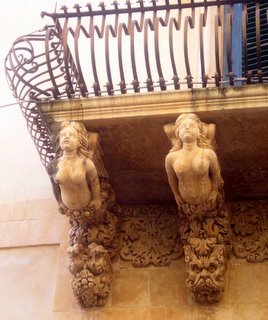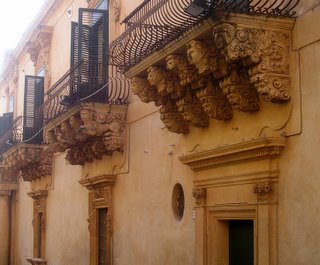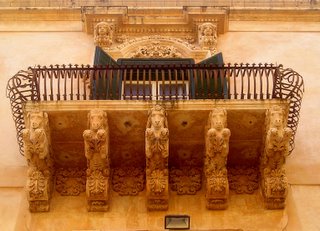Sicilian Baroque
 I've always been a fan of Baroque architecture, and Sicily does it particularly well. For one thing, the interior of every single church I've seen is Baroque! No matter how old or decrepit the church is on the outside, it will have a beautiful ornate Baroque interior, for sure, all white and gold and painted ceilings, swirls, and light. I love it.
I've always been a fan of Baroque architecture, and Sicily does it particularly well. For one thing, the interior of every single church I've seen is Baroque! No matter how old or decrepit the church is on the outside, it will have a beautiful ornate Baroque interior, for sure, all white and gold and painted ceilings, swirls, and light. I love it.One can see Baroque just about everywhere on the eastern side of the island (MY side), and, when I heard about the "Baroque towns of Sicily," I put them high on my "must-see" list. Catania has lots of it, Siracusa even more, but THE Baroque towns are Noto, Ragusa, and Modica, all in the southeastern part of Sicily.
Why these three towns? Well, unfortunately, or fortunately, they were all destroyed in a huge earthquake in 1693 and rebuilt when Baroque was at its most popular and opulent. So, out of a tragedy that killed over 60,000 people came these new Baroque towns. What kind of optimism those Sicilians must have had to rebuild in this bold new style!
On a sunny, warm day in early November, I had the chance to visit Noto (I'm hoping to see the other two over Christmas). It's like walking through a movie set, there's so much in a small space! Churches, public buildings, palaces, fountains, the theater--all, all in fantastically beautiful Baroque! Recently, Noto became a UNESCO site, which means lots of money from the outside is being put into restoring and saving the old buildings. Because Sicily has been the poorest part of Italy for so long, it's really quite run-down and even falling-down in some places. It reminds me of the Czech Republic right after the Iron Curtain lifted--beautiful, opulent, but really run-down. So it is with Noto, although much has already been restored and it's wonderful see the others in progress.

In Noto, most of the important buildings are on one street which is easy to walk up and down. Noto is, in fact, not a big town, anyway, which rather makes the sheer amount of Baroque architecture even more phenomenal. The other important buildings are just one street either way of the main street, which is the Corso Vittorio Emmanuele. On it you'll find the cathedral, the theater, the Palazzo Ducezio, several other churches and palaces. Turn up the hill on any side street and you'll find even more fabulous examples! My personal favorite is the Palazzo Nicolaci for its ornate balconies and windows.
Hopefully, the cathedral will be unveiled and opened soon. It's already overdue. Apparently, the entire ceiling fell in in 1996, luckily killing no one, although a couple of priests were inside. It had been weakened in an earthquake a few years earlier and the money somehow never got there to repair it (typical Sicilian graft). But now, it is being rebuilt and repaired and should open soon, re-establishing itself as the center of the town.
My landlord, Sebaastiano Belfiore, was born in Noto. He is fond of telling me this: "Io nato a Noto!" (I was born in Noto.) He likes the way this sounds, and so do I. :-)



2 Comments:
I just discovered this site. Your photos are wonderful. I have been to Italy many times but never to Sicily. Am looking for a language school. How do you arrive in Sicily from the States? Is it easy to get around? Are the people friendly?
Thanks for the time and effort. JM
The people are very warm and friendly, but watch out for their driving! Sicily has two international airports, one at Palermo and one at Catania. It is easy to get around, especially if you rent a car. Truthfully, driving is easy outside of the cities. I have a post about driving. There are some language schools here. I know, because I contacted them all last year. Have you found anything?
Post a Comment
<< Home